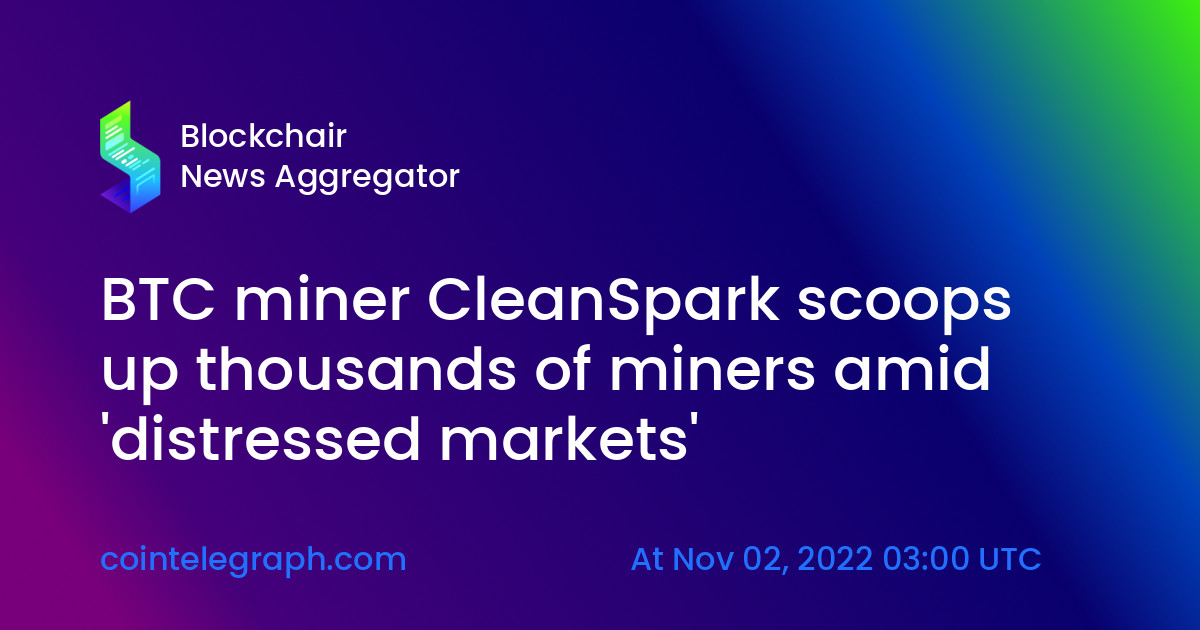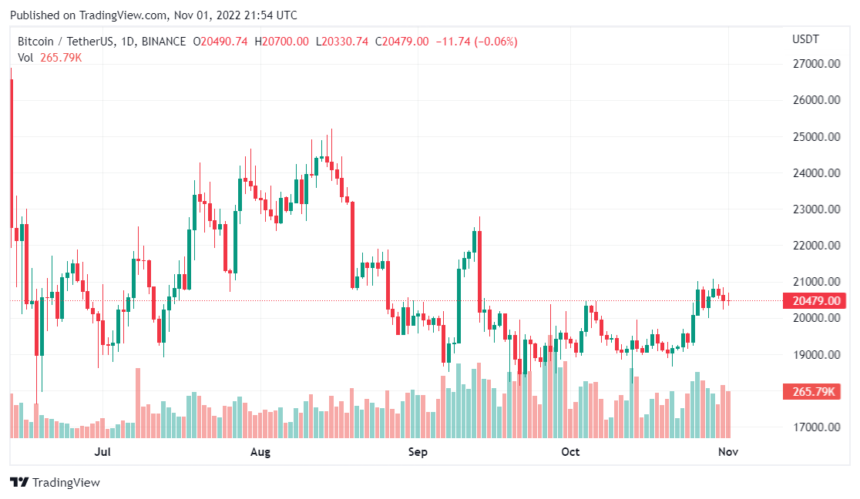Publicly traded North American mining companies produced a smaller share of new bitcoin last month, slipping to 17.5% of the total network, the report said.
Argo Blockchain cuts 2022 debt by half, down to $75M

Cryptocurrency mining firm Argo Blockchain has reduced its debts to $75 million through the first half of 2023.
Crypto Miner Argo Blockchain Raises $7.5M in Share Sale; Stock Slumps
Proceeds from the private placing and public sale will be used to pay down debt.
Marathon Digital attributes 21% decline in Bitcoin mined to adverse weather conditions

Marathon Digital also noted that the decrease in transaction fees for June was not a cause for concern, highlighting that Bitcoin Ordinals had provided a boost in the previous month.
Argo Blockchain Slumps to Full-Year Loss on Bitcoin Price Slide
The crypto mining company is in a stronger position now, interim CEO El-Bakly said
Intel Discontinues Bitcoin Mining Chip Series
The chip-making heavyweight’s first customers for bitcoin mining ICs were Argo Blockchain, Hive Blockchain, Block and Griid Infrastructure.
Argo Blockchain accused of misleading investors in class action lawsuit

After a torrid 2022 that saw it sell off its flagship mining facility, Argo Blockchain’s woes are worsening after a recent class action suit.
Mike Novogratz calls Helios a ‘transformative acquisition’ for Galaxy

The Galaxy CEO seems unfazed by the carnage in the BTC mining sector this year, and outlined that the firm is looking to significantly ramp up its mining initiatives.
Argo Blockchain reports insufficient funds, ‘no assurance’ it can avoid Chapter 11 bankruptcy

According to the mining firm, “inadvertently published materials” led to the suspension of trading of Argo Blockchain on the London Stock Exchange and Nasdaq on Dec. 9.
BTC miner CleanSpark scoops up thousands of miners amid ‘distressed markets’

CleanSpark bought over 3,800 mining machines at $15.50 per terahash – far below the current market price of $22.94 and an 85.4% discount from the all-time high costs of $106.62 in Dec. 2021.
Bitcoin Mining Giant Argo Blockchain Gets Negative Cash Flows And Stock Price Dips
Though the crypto winter seems to be over, its impact on Bitcoin and the crypto market still lingers. Several crypto-related firms have gone down the drain over the pressure in the market. Some are still battling to stay afloat despite the forces’ influence while managing their operations.
Most companies related to Bitcoin mining are getting more heat from the fluctuating market trend. Most Bitcoin miners have shut down businesses, but some filed for bankruptcy as they couldn’t weather the storm.
Argo Blockchain is reportedly facing a negative cash flow, with the value of its shares declining. The pressure is getting more intense for the crypto mining giant in financing its continuous operation. More failures in such financing quests could lead to a halt in its process or a drastic cash drop in the future.
Bitcoin Mining Giant Argo Blockchain With No Adequate Sources To Fight Insolvency
The BTC miner released a press statement disclosing its previous financial plans. It noted how the firm has been exploring diverse economic opportunities. However, it has no concrete assurance in signing such agreements or completing fruitful transactions.
It revealed that the company needs to consummate financial activities offering enough working capital for its operational requirements. Such economic growth is necessary for its sustainability in the next twelve months from today to avoid becoming bankrupt.
According to the press, the firm had a partnership plan with an investor to generate $27 million through shares subscription. However, the attempt came out unsuccessful.
Also, Argo Blockchain reported the sales of some of its mining equipment to preserve cash and enhance its liquidity. For example, it recorded selling about 3,843 brand-new Bitman S19J Pro machines in the firm’s last batch of inventory scheduled for October.
Argo Blockchain Stock Plummets
Following the recent downward financial stance, Argo’s shares performance has plummeted. The data indicated a decline of almost 50% over the past 24 hours. Also, the stocks report from the beginning of the year shows a dip of over 80%.
The struggle by Argo has been going on for some time now. Finally, the Bitcoin mining firm got a $25 million BTC-backed loan from Galaxy Digital, an investment management company, in September 2021. The loan targets to support the miner’s cash flow requirements and expansion plans in West Texas.
Argo has been selling its BTC, holding monthly throughout 2022. This move is the necessary option to cut down its part of the agreement and increase its balance sheet. In June this year, the firm sold about 637 Bitcoin at $24,500 per token.

However, it seems to sell more Bitcoin tokens than it has produced. In June, the company mined about 179 BTC but sold 637 BTC coins.
featured Image From Pexels, Charts From Tradingview
Crypto miners in Texas shut down operations as state experiences extreme heat wave

ERCOT reported that wind generation in Texas was “generating significantly less,” potentially leaving the state unable to meet energy demands during triple-digit temperatures.
Another miner cashes in: Argo Blockchain reports selling 637 BTC to pay debts

Argo reported it had an outstanding balance of $22 million on a loan from Galaxy Digital, from which it secured BTC-backed loan agreements in 2021.
Intel Ships Blockscale ASIC Chips To Selected Bitcoin Mining Companies
It’s official, Intel is part of the bitcoin mining business. The gargantuan technology company announced its “ultra-low-voltage energy-efficient” ASIC chip barely six months ago, and it’s already here. Under normal circumstances, infrastructural support from a multinational company like Intel would be tremendous for the bitcoin market. How will it react in the middle of all this chaos? Will it react at all? The news didn’t immediately do much, but the long-term effect remains to be seen.
Intel AXG Custom Compute team is now shipping the Blockscale ASIC! First product will always be unforgettable, congratulations team
Excited to see how @ArgoBlockchain @griid and @HiveBlockchain improvise around Blockscale and our open design. pic.twitter.com/0rxtNTLMfw
— Raja Koduri (Bali Makaradhwaja) (@RajaXg) June 29, 2022
Raja Koduri, Intel’s Architecture, Graphics and Software (IAGS) division’s senior vice president, recently tweeted:
“Intel AXG Custom Compute team is now shipping the Blockscale ASIC! First product will always be unforgettable, congratulations team. Excited to see how Argo, Griid and Hive improvise around Blockscale and our open design.”
Notably absent from the list is BLOCK, Jack Dorsey’s company. Does that mean something or is BLOCK just fourth on the list? Three months ago, Bitcoinist quoted Raja Koduri emphatically saying:
“Our blockchain accelerator will ship later this year. We are engaged directly with customers that share our sustainability goals. Argo Blockchain, BLOCK (formerly known as Square) and GRIID Infrastructure are among our first customers for this upcoming product.”
The Bitcoin Miners React To Intel’s Announcement
Green mining company Hive was the first to react, they tweeted “HIVE is proud to have partnered with Intel, and we can’t wait to put the new ASICs to good use mining BTC!” A few months ago, the company was much more eloquent in a press release NewsBTC quoted. “These miners are expected to be delivered over a period of one year starting in the second half of calendar 2022, the effect of which, if they are all installed, would be an expected increase of up to 95% in our aggregate Bitcoin mining hashrate from 1.9 Exahash per second.”
$HIVE is proud to have partnered with @intel, and we can’t wait to put the new ASICs to good use mining $BTC! https://t.co/qDWKnU95MI
— H I V E (@HiveBlockchain) June 29, 2022
For their part, Argo also went the simple route and tweeted. “Thanks, Raja Koduri and Intel. We’re excited to be innovating with these new ASIC chips in our custom immersion mining rigs. Our thanks to ePIC Blockchain for joining us on the ride.” That new player, ePIC Blockchain Technologies produces self-proclaimed “North American Designed ASIC RIGs.” So, innovation and customization are on the way.
Thanks, @RajaXg and @intel. We're excited to be innovating with these new ASIC chips in our custom immersion mining rigs. Our thanks to @ePICBlockchain for joining us on the ride. https://t.co/pKlxDjkm08
— Argo (@ArgoBlockchain) June 29, 2022
Last but not least, let’s remember Raja Koduri’s words when Intel’s bitcoin mining experiment started:
“Today, we at Intel are declaring our intent to contribute to the development of blockchain technologies, with a roadmap of energy-efficient accelerators. Intel will engage and promote an open and secure blockchain ecosystem and will help advance this technology in a responsible and sustainable way.”
Remember that statement as we pass to the next section.
BTC price chart for 07/04/2022 on Bitfinex | Source: BTC/USD on TradingView.com
Mainstream Media Mocks Intel
In the eyes of mainstream media, bitcoin or anything related to it can’t do anything right. And this bear-market-of-sorts we’re into gives them the perfect ammunition to attack the technology and the billion-dollar market around it. Luckily, bitcoin doesn’t care. In the first mainstream article about Intel shipping its Blockscale ASIC chips ahead of time, The Register starts with valuable information:
“Blockscale is shipping a couple days ahead of Intel’s previously stated release window for the third quarter, which begins Friday. Even if it’s a tiny head start, it is nonetheless an achievement for a corporation that is becoming notoriously under-schedule across multiple products, including the Sapphire Rapids server chips and the discrete Arc GPUs.”
Only to then, start dunking on bitcoiners and Intel alike. They start with this:
“Experts and company officials are warning that the world of blockchain-fueled digital currencies is entering a crypto winter, a period where the value of virtual coins plunge and remain low. This last happened between early 2018 and mid-2020.”
And then, they dedicate 1000 words to the market’s condition instead of discussing Intel’s SEG energy-efficient intentions. Or the perfectly executed roll-out strategy that the company exhibited these last few months. Or the fact that bitcoin is humanity’s only hope.
Featured Image: Blockscale promotional image from this tweet | Charts by TradingView
Argo Blockchain facility in West Texas expects to start mining Bitcoin in May

The company expects a hash rate of 5.5 EH/s by the end of 2022, anticipating that access to an additional 600 MW of power capacity “in the coming years” will produce 20 EH/s.
Senate Finance Committee Chair probes “lack of safeguards” in crypto tax incentives

A new push for clarity on compliance from Senator Wyden aims to ensure economically distressed communities receive promised benefits from crypto mining companies.
Malice Or Ignorance? The New York Times Keeps Printing Lies About Bitcoin Mining
The New York Times’ campaign against bitcoin rages on. Even though this time they had the perfect opportunity to write a balanced article, they didn’t. The author reports one positive bitcoin mining story after another, while keeping a snooty attitude and suggesting it’s all a PR move. The title summarizes the New York Times’ stance, “Bitcoin Miners Want to Recast Themselves as Eco-Friendly.”
Related Reading | Valkyrie Bitcoin Mining ETF “WGMI” Approved For Nasdaq Listing
Before we get into it, a quick story. The foremost expert in bitcoin’s energy consumption, Nic Carter, published an exhaustive report on mining. Among other things, it contained hard data that showed to what extent China was mining using hydropower energy. Mainstream media largely ignored it. The party line was that we couldn’t trust China’s statistics. And, that China was probably burning cole.
Fast forward to last month. China banned bitcoin mining a while ago and bitcoin’s hashrate relocated, recovered, while the network functioned perfectly throughout. Most of China’s mining industry relocated to green energy-abundant countries. What did the New York Times post? An article called “China Banished Cryptocurrencies. Now, ‘Mining’ Is Even Dirtier,” that claims that Chinese miners were using hydropower energy and thus used cleaner energy.
That’s the level of propaganda we’re dealing with.
What Did The New York Times Say About Bitcoin Mining This Time?
The article starts by featuring Argo Blockchain, the company is building a new facility that “would be fueled mostly by wind and solar energy.” They even quote Peter Wall, Argo CEO, saying. “This is Bitcoin mining nirvana. You look off into the distance and you’ve got your renewable power.” What could be wrong with that?
Two paragraphs later, the New York Times starts pushing lies and embarrassing numbers:
“A single Bitcoin transaction now requires more than 2,000 kilowatt-hours of electricity, or enough energy to power the average American household for 73 days, researchers estimate.”
Of course, those ridiculous claims come from Digiconomist, a widely debunked researcher who happens to be an employee of the Dutch Central Bank. And then, they blatantly quote the malicious study mentioned in the intro.
“The Bitcoin network’s use of green energy sources also dropped to an average of 25 percent in August 2021 from 42 percent in 2020. (The industry has argued that its average renewable use is closer to 60 percent.) That’s partly a result of China’s crackdown, which cut off a source of cheap hydropower.”
And quote Alex de Vries, one of the study’s authors, being completely off the mark. “What a miner is going to do if they want to maximize the profit is put their machine wherever it can run the entire day.” WHAT? To maximize profit, a miner is going to find the cheapest source of energy possible. Energy is their biggest cost. The cheapest source possible is energy that’s currently being wasted. That’s the situation.
BTC price chart for 03/26/2022 on Forex.com | Source: BTC/USD on TradingView.com
More Feel-Good Stories Framed As Bad News
The New York Times even quotes Paul Prager, TeraWulf CEO, saying “Everyone I talk to now is talking about carbon neutrality. The language has absolutely changed.” And then, the newspaper spreads the good news.
“TeraWulf, has pledged to run cryptocurrency mines using more than 90 percent zero-carbon energy. It has two projects in the works — a retired coal plant in upstate New York fueled by hydropower, and a nuclear-powered facility in Pennsylvania.”
None of these stories are celebrated. Remember the article’s title, they are cynically presented as PR stunts. Then, it´s time for Sangha Systems, who “repurposed an old steel mill in the town of Hennepin. Sangha is run by a former lawyer, Spencer Marr, who says he founded the company to promote clean energy. But about half the Hennepin operation’s power comes from fossil fuels.”
The New York Times Closes The Loop
That’s the worst example that the New York Times could find. A person who “founded the company to promote clean energy” but had to make a compromise to start his business. To close the article, the author brings us back to Argo Blockchain and tries to pull something similar. Apparently, the CEO “can’t guarantee that Argo’s new center will have no carbon footprint. That would require bypassing the grid and buying energy directly from a renewable power company.”
Related Reading | Biden Loves Intel’s Plan To Produce Semiconductors. What About Bitcoin Mining?
And then, they quote him again. “A lot of those renewable energy producers are still a little bit skeptical of cryptocurrency. The crypto miners don’t have the credit profiles to sign 10- or 15-year deals.”
So, Argo is really trying but it’s not possible at the moment for understandable reasons. And the whole industry is moving to a greener path because the incentives are aligned that way. Got it, New York Times. Got it.
Featured Image by tacskooo on Pixabay | Charts by TradingView
Green Mining Company HIVE Secures Deal To Buy A Number Of Intel’s New ASICs
The ESG-focused mining company HIVE is the latest organization to sign a deal with Intel. It joins Block, Argo Blockchain, and GRIID, as the first clients and testers of the giant’s new ASICs. Intel’s Bonanza Mine project is quickly becoming one of bitcoin’s stories of the year. It’s funny that, so far, no one has seen the equipment. The idea of a bitcoin miner made in the US is appealing, though. Plus, the project’s rollout has been masterful so far.
The headline here is that “HIVE owns state-of-the-art, green energy-powered data centre facilities in Canada, Sweden, and Iceland, where we source only green energy to mine.” In a recent press release, the company announced the Intel deal and its intention to expand into the US. “The Company is planning for a 100 MW deployment at one of Compute North’s renewable energy campuses in Texas.”
HIVE self-proclaimed itself “the first cryptocurrency mining company with a green energy and ESG strategy”. The company’s other significant characteristic is that they’re holders. “Since the beginning of 2021, HIVE has held in secure storage the majority of its ETH and BTC coin mining rewards.” That goes in line with new data that shows that miners are quietly accumulating bitcoin as the market bleeds.
BTC price chart for 03/08/2022 on Capital.com | Source: BTC/USD on TradingView.com
What Do We Know About HIVE ‘s Deal With Intel?
Not much, really. “HIVE has entered into a Supply Agreement with Intel which is one of the world’s largest semiconductor manufacturers, for their upcoming blockchain accelerator.” Notice how HIVE calls the ASICs “blockchain accelerators,” just as Intel did in the company’s blog. Will the name catch on?
The press release doesn’t specify how many bitcoin miners will HIVE buy, but, it provides some relevant data:
“These miners are expected to be delivered over a period of one year starting in the second half of calendar 2022, the effect of which, if they are all installed, would be an expected increase of up to 95% in our aggregate Bitcoin mining hashrate from 1.9 Exahash per second.”
It also quotes HIVE ‘s president, Aydin Kilic, who about the deal said:
“After months of careful planning, we are very excited to take this step forward with a global technology leader like Intel. HIVE is committed to implementing these next-generation blockchain accelerators in its green energy infrastructure.”
The ESG aspect of the whole endeavor is another important point here.
Bitcoin Keeps Going Greener And Greener
Recently, GRIID’s filling with the SEC revealed several characteristics of Intel’s new bitcoin miners. As always, NewsBTC got you the 411:
“When the world first heard about Intel’s ASIC ambitions, the company cleverly described the machines as “ultra-low-voltage energy-efficient.” How efficient will they actually be? Tom’s hardware answers:
“According to the listing, BMZ2’s performance weighs in at 135 TH/s with 26 J/THs of efficiency. Additionally, the miner is roughly half the cost of a competing Bitmain S19 Pro while being 15% more efficient, rivaling the best hardware on the market from competing companies.”
Would 15% really make that much of a difference? If it can rival the S19 Pro, it would. And Intel wouldn’t make this much noise if they didn’t have a winner in their hands, would they? Maybe HIVE ‘s president, Aydin Kilic, can shed some light on that:
“Intel’s energy-efficient and high performance blockchain accelerator is expected to reduce our power consumption over current ASIC miners on the market. HIVE will participate in the system development process from design verification, through to the prototype stages, and then factory & test engineering regimens to arrive at a production model; we are well-positioned and excited to undertake the process ahead.”
That’s right, the first few clients will help with the testing and development of Intel’s final product. That makes all the sense in the world. Let’s wish them luck, because an ASIC miner made in the US would certainly help break Bitmain’s quasi-monopoly. The bitcoin ecosystem needs more decentralization in that aspect.
Featured Image: HIVE’s logo, screenshot from this video | Charts by TradingView
Intel Announces Mining Chips’ First Clients: BLOCK, Argo Blockchain, and GRIID
Intel ’s play to get into the bitcoin mining market might end up being the story of the year. In a post titled “Blockchain and the New Custom Compute Group,” Raja Koduri reveals a little of the company’s playbook. At Intel, he’s the senior vice president and general manager of the Accelerated Computing Systems and Graphics Group.
Related Reading | Jack Dorsey’s Block To Democratize Bitcoin Mining With Open Source Mining System
In the article, Koduri says, “we are focusing our efforts on realizing the full potential of blockchain by developing the most energy-efficient computing technologies at scale.” Intel’s play is deeper and harder than previously thought. They’re going all-in in the blockchain business. With a twist that every corporation is claiming for.
“Today, we at Intel are declaring our intent to contribute to the development of blockchain technologies, with a roadmap of energy-efficient accelerators. Intel will engage and promote an open and secure blockchain ecosystem and will help advance this technology in a responsible and sustainable way.”
That’s right, they’re tackling the problem “in a responsible and sustainable way.” And they’re calling the mining chips “accelerators” for some reason. Will the name catch on?
“Intel Labs has dedicated decades of research into reliable cryptography, hashing techniques and ultra-low voltage circuits. We expect that our circuit innovations will deliver a blockchain accelerator that has over 1000x better performance per watt than mainstream GPUs for SHA-256 based mining.”
This new line of Intel products responds directly to the ESG crowd. The bitcoin-consumes-too-much-energy FUD people. Soon enough, they’ll have to face Intel ’s PR machine. How can bitcoin consume too much energy if Intel’s product “has over 1000x better performance per watt than mainstream GPUs for SHA-256 based mining”?
BTC price chart for 02/14/2022 on Kraken | Source: BTC/USD on TradingView.com
Who Are Intel ’s First Clients?
We can’t prove it, but, all of these companies probably knew years ago about Intel’s plans to release a bitcoin mining chip. Again, Raja Koduri:
“Our blockchain accelerator will ship later this year. We are engaged directly with customers that share our sustainability goals. Argo Blockchain, BLOCK (formerly known as Square) and GRIID Infrastructure are among our first customers for this upcoming product. This architecture is implemented on a tiny piece of silicon so that it has minimal impact to the supply of current products.”
When NewsBTC analyzed Intel’s chip announcement, we summarized the situation as:
“This could be huge. Intel plans to enter the Bitcoin mining space with a cleverly marketed “ultra-low-voltage energy-efficient” ASIC chip. Considering that the chip shortage severely delayed the next generation of ASIC miners, this is tremendous. And, more importantly, it opens up the door for Bitcoin miners manufacturing in the USA. And in the rest of the Western world, even. ”
After that, we analyzed the situation’s implications:
“Now, the open-source Bitcoin miner that Jack Dorsey’s Block is working on makes a lot more sense. Theoretically, the silicon chip is the only part of an ASIC machine that can’t be bought in a hardware store. With that problem solved, by no less than an industry leader with immense manufacturing power, the sky’s the limit. If this whole thing materializes, expect a huge leap forward in the further decentralization of Bitcoin mining.”
Notice how Block is one of the first clients. And how Intel had the energy-efficient ASIC chip marketing ready from the get-go. And how Koduri even addressed the chip shortage in the last line there.
Intel’s Bonanza Chip’s Future
Reading between the lines, it’s clear that this is not a secondary project for Intel. They have high hopes for this low-energy chips play. Here, Koduri discusses the Custom Compute Group:
“The objective of this team is to build custom silicon platforms optimized for customers’ workloads, including blockchain and other custom accelerated supercomputing opportunities at the edge.
Onward, we aspire to leverage technologies from our zetta-scale computing initiative to deliver energy-efficient solutions.”
Related Reading | Green Energy: In NY, Bitcoin Mining Saved The Oldest Working Hydroelectric Plant
You read it here first, Intel ’s play to get into the bitcoin mining market might end up being the story of the year.
This is not financial advice, though.
Featured Image by geralt on Pixabay | Charts by TradingView
Argo Blockchain among most traded stocks by Fidelity customers

Shares of the mining firm beat out BP and Lloyds Banking Group to become one of the stocks most actively traded by Fidelity customers in 2021.




